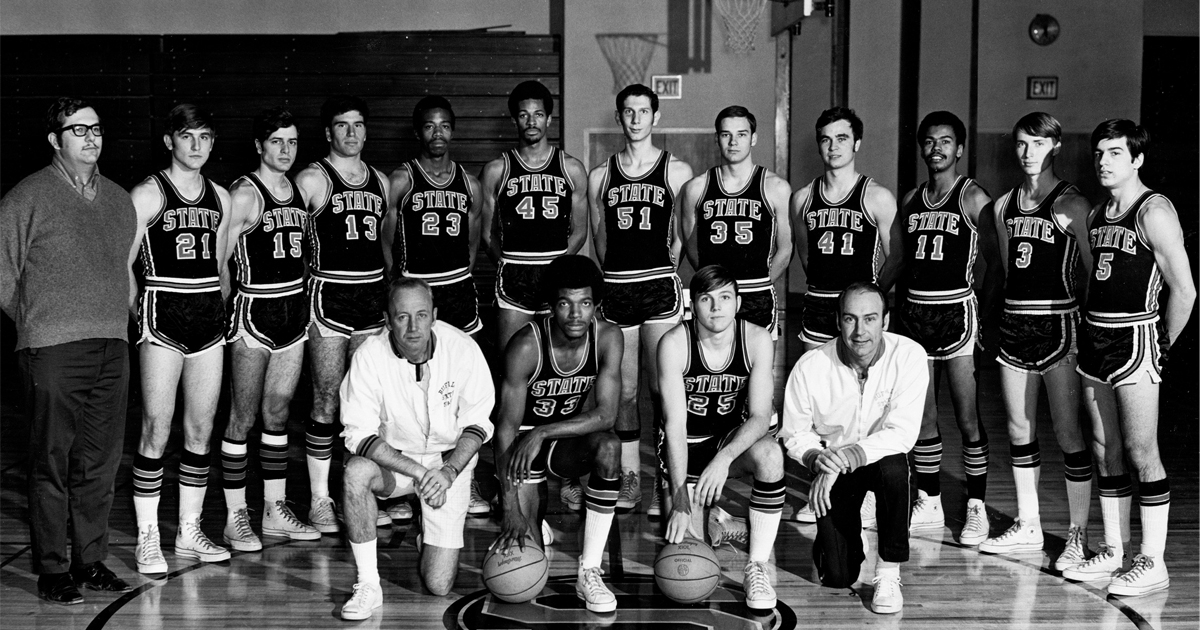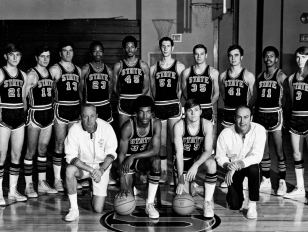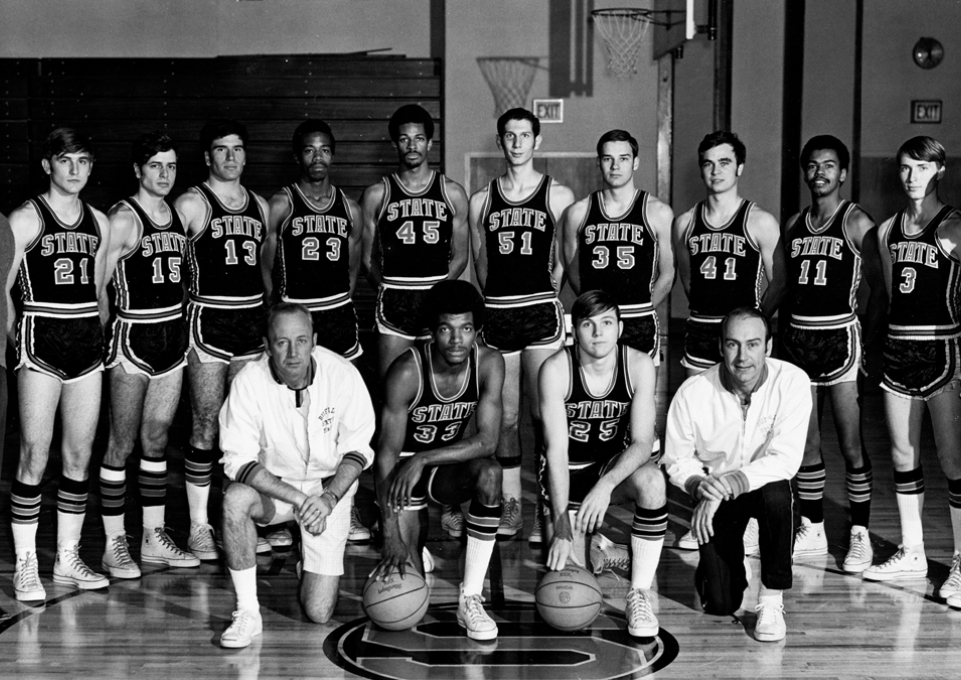
When Peter Drumsta, ’73, arrived on campus as a freshman in the fall of 1969, he knew he wanted to write for Buffalo State’s award-winning student newspaper.
“Joining the Record was an automatic,” said Drumsta, who had already begun writing for the Tonawanda News while in high school and went on to a 40-year career in news writing. “I knew that I wanted to do nothing else but work for newspapers—and the Record was a really vibrant place to do that. We strived to be a legitimate news organization, not just students bloviating about this and that.”
World events provided no shortage of serious material. In addition to covering on-campus happenings—like a Dionne Warwick concert that headlined Homecoming Weekend activities that year—Record editors offered thoughtful reporting on the Vietnam War, the civil rights movement, the feminist movement, and the advent of Earth Day. A tumultuous mix of social issues and politics whirled through daily life, and Buffalo State students in their late teens and early twenties were trying to make sense of it all.
“It was essentially a clash of old and new values,” Drumsta said. “Some students were on board with the traditional way of doing things; others were definitely not. And we were all thrown together at this state school at a crazy time, not really knowing what the future held.”
GREAT EXPECTATIONS?
Speaking of the unknown, the Buffalo State men’s basketball team entered the 1969–1970 campaign with tempered expectations. The team was coming off a solid 16-win season from the year before, but the roster had changed considerably.
In a brief season preview column, the Record summed up the state of the team in very matter-of-fact terms: “Although we lost five of our first eight players due to graduation, the team shows good speed and fine shooting ability.”
“Heading into the season, we had no idea what this team was really capable of,” recalled Drumsta, who was assigned to cover the cagers for the Record, along with Alan Geller, ’71. “Of course, we did realize—and this is a basketball truism—when you have the best player on the floor, good things usually happen. And we happened to have a guy named Randy Smith.”
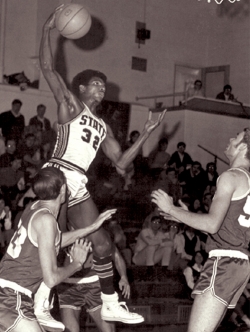 Everything started with Randy Smith (pictured). An outrageously talented all-around athlete from Bellport, Long Island, Smith starred for “State” in basketball, soccer, and track and field.
Everything started with Randy Smith (pictured). An outrageously talented all-around athlete from Bellport, Long Island, Smith starred for “State” in basketball, soccer, and track and field.
“Randy was the absolute best,” remembered Patrick Abulone, ’72, a plucky guard who moved up from the freshman team to the varsity squad that season. “Randy could do things on the court that no one else could. He was one of a kind.”
The freshman team pipeline also sent Ken Zak, Mike Coleman, Dave Robinson, Brian North, and John Rosetti to varsity. Senior co-captain Tom Borschel and juniors Jeff McLimans, Joe Bienko, and Noel Galluch would be relied on for veteran presence. And junior college transfers Glenn Henley, Johnnie McIntosh, and Dennis Adams provided a promising X factor.
At the helm was head coach Howard “Howie” MacAdam, who was entering his ninth season with the Bengals. MacAdam also served as the college’s athletics director and was aptly described by Drumsta as the “the coach who doesn’t look like a coach.”
MacAdam is not a drill sergeant—he is an astute teacher, and the gymnasium is his classroom…. Much of his coaching success can be attributed to the fast-break offense, a plan of his own creation which he claims “is not for nervous coaches.” There will be no sideline antics this or any season for MacAdam. His system calls for a quick-hitting offense, not allowing the opposing defense to set up.
—The Record, December 3, 1969
LET’S GET IT STARTED
The season started on a memorable note—a 94-59 blowout win over the University of Toronto and, yes, a halftime name change for the Buffalo State athletic teams. The New Gym at Buffalo State accommodated 1,000-plus spectators, and the Record reported a capacity crowd for the opener and a raucous capacity crowd for the second game of the season, a hard-fought win against Brockport:
It was a sore-throated crowd that filed out of the New Gym, a group that was constantly voicing their approval of some outstanding plays and its disapproval of many near-sighted calls by the two referees.
—The Record, December 10, 1969
Buffalo State’s hot start happened within the context of what would turn out to be the single greatest season in Western New York college basketball history.
Down the road in Olean, 6-foot-10 All-American center Bob Lanier was leading St. Bonaventure University to a top-10 national ranking in the NCAA University Division. And at Niagara University, 5-foot-9 All-American guard Calvin Murphy was leading the Purple Eagles to a top-20 national ranking. At the time, NCAA-affiliated universities were divided into the top-tier University Division and the second-tier College Division. Buffalo State and its fellow State University of New York Athletic Conference rivals played in the College Division but often included University Division teams on their schedules.
For Buffalo State, an early season contest against Niagara in downtown Buffalo’s Memorial Auditorium provided an opportunity to gauge just how good the Bengals really were.
“That was a great game,” Abulone said. “I vividly remember guarding Calvin Murphy that night. He would always take a few dribbles, then pull up quickly from 20 feet out. I was a guy who always boxed out, and on one shot, I knocked Calvin on his back on a box-out, and the Niagara coach, Frank Layden, yelled at me so loud you could hear him over the whole crowd!”
Niagara seized control of the game early, building an 11-point lead in the first half, but the never-say-die Bengals took advantage of a foul-troubled Murphy to trim the deficit to 1. Murphy extended Niagara’s lead to 13 points in the second half, but once again, Buffalo State rushed back. With just over two minutes to play, Henley and Borschel led a furious comeback attempt, but the Bengals came up short, 83-80.
“No question. I think Randy and Buffalo State felt a bit overshadowed and maybe a little underappreciated in Western New York basketball circles,” Drumsta said, “but that game showed that we could go toe-to-toe with the big boys.”
LET’S GET ‘GLAD’
By January, the Bengals were hitting their groove. Literally.
Randy Smith picked the song “Glad” as the team’s warm-up music for home games. Composed by Steve Winwood and performed by the English rock band Traffic, “Glad” was the opening track of the John Barleycorn Must Die album. It was the perfect soundtrack for a new decade and a ball club brimming with confidence—upbeat rock-jazz driven by runaway piano, relentless percussion, and ultracool, wah-wah pedal saxophone. Bah-da-da-bop-da-dah… Bah-da-da-bop-da-dah.
Students, faculty, and staff were captivated by the team’s charisma and success.
“The basketball team grabbed everyone’s attention that winter,” Drumsta recalled. “The team became a rallying point on campus amidst the war and craziness of the world. We came together in the gym around a terrific team. It seemed like everyone was at those games.”
Abulone remembers it the same way: “The gym was full every night. Standing room only. It was the place to be on campus. Students would enjoy the game, and then everyone went over to the Masthead afterward.”
In January and February, the Bengals reeled off 13 wins in 14 games—with signature victories over Gannon, then the fourth-ranked team in the country in the NCAA College Division, and the University at Buffalo, a strong squad led by flashy scorer Ron Gilliam.
The regular season concluded with a resounding 105-74 win at Geneseo, a team that had entered the contest undefeated at home and with the same 17-3 record as Buffalo State. A 27-point outburst by Zak cinched the game and the conference championship for the Bengals, and more exciting news was announced after the game.
Based on the college’s successful hosting of tournament games in the past, the NCAA named Buffalo State as the host site for the College Division Eastern Regionals.
WELCOME TO OUR HOUSE
The Eastern Regionals featured a March 6 doubleheader of Hartwick College versus Montclair State and Buffalo State versus Stony Brook. The winners would play each other the following night for the right to advance to the national quarterfinals, now known as the Elite Eight.
In the opening game, a fired-up Bengal team overwhelmed Stony Brook, 93-69.
The Regional final game pitted the Bengals against Montclair State.
Abulone remembers the scene as if it were yesterday: “It was crazy. The gym was packed, and fans in the front row were just a few feet from the court. When the other team took the ball out, they could feel the fans breathing on them.”
The visitors took a 10-point lead into the halftime break. “Poor shooting, ineffective rebounding, nonchalant defense all attributed to the inept play [of Buffalo State]," Geller wrote in his Record account of the game.
Fortunately for the home crowd, the Bengals roared back in the second half because, as Drumsta knew, the Buffalo Staters had the best player on the floor. Smith powered a 12-2 run with two jumpers and a tap-in to cut the Montclair lead from 11 to 1 with five minutes remaining. He then sealed the deal with a flurry of layups, fall-away jumpers, and free throws. He tallied an astounding 29 points in the second half and 39 in the game.
“Randy could elevate like no other,” said Drumsta, whom Smith had dubbed “Clark Kent” for his resemblance to the mild-mannered reporter and Superman’s alter ego. “Down the stretch of a close game, when other teams were playing zone defense, MacAdam would have Randy run in the lane over and over again and get that entry pass and just elevate over the defense for an 8- or 10-footer. Especially against smaller teams, that play was unstoppable. That’s what he did that night against Montclair.”
As the clock ticked to zero, New Gym turned into Times Square on New Year’s Eve. Students spilled onto the court and hoisted Smith on their shoulders and carried him around the court. The players climbed a ladder to cut down the net.
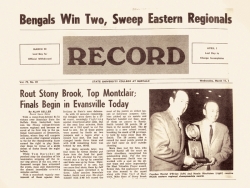 The Record recorded it this way for the ages:
The Record recorded it this way for the ages:
Saturday night there were 2,000 people on the Buffalo State basketball team, all of them overjoyed. They were a part of the Bengals comeback victory over Montclair State, and afterwards they staged a rally of their own…. Had the game been played anywhere else, the result would most probably have been different, but the Bengals couldn’t bear to lose at home before a crowd that wouldn’t quit. They experienced everything except defeat; they were down at the half, booed every “bad” call, and went wild with every Buffalo basket… But win they did, and for coaches, players, and fans, it was a dream come true.
—The Record, March 11, 1970
ON TO THE FINAL FOUR
As regional champions for the first time in school history, the Bengals headed to Evansville, Indiana, for the College Division national tournament. First on the schedule was a quarterfinal matchup with Stetson University of Florida.
“I remember the team walking into the arena in Evansville [Roberts Municipal Stadium] when we got there,” Abulone said. “We walked in at the top level, looking down from above at 12,000 seats. It was unbelievable. It was huge. It really felt like we had hit the big time.”
Drumsta was desperate to witness the historic event in person, so he did what a college student without a car did in those days: he hitchhiked.
“Unfortunately, we got as far as Cincinnati and realized that we’d never make it to Evansville in time for the first game, so we headed back to Buffalo,” Drumsta said.
He missed a thriller. Down 40-35 at halftime, MacAdam called for a 2-1-2 zone press in the second half, a strategy that worked beautifully. Smith poured in 12 points in the final 10 minutes of play to keep the game close. With the score tied 74-74, Borschel and Henley forced a critical turnover. Henley scooped up the loose ball with seven seconds on the clock and was fouled. In one of the most clutch moments in Buffalo State athletic history, Henley sank the first shot for the lead—and the win—and propelled the Bengals into the Final Four.
In the national semifinal, Buffalo State squared off against Tennessee State and their superstar trio of All-American guard Ted McLain, 6-foot-8 Lloyd Neal, and 6-foot-7 Claude Grant. As the Record put it, the Bengals were “outstretched and outrebounded” and fell hard, 101-80, despite 35 points from Smith and 23 from Borschel.
“In Evansville, we were just a little overmatched in height. I drove down the lane for a layup and ate a Rawlings sandwich,” Abulone joked. “We really wanted to win, so we were disappointed when we lost big to Tennessee State in the semifinal, and that showed in the runner-up game the next day.”
In the consolation game, the University of California at Riverside prevailed, 94-83, but the Bengals had already secured their legacy.
THE FOREVER TEAM
The Bengals returned home to great fanfare and accolades. Students returned to the Masthead to toast the once-in-a-lifetime season. An “All American Night” dinner was held at the Statler Hilton’s Grand Ballroom downtown to honor Western New York’s three outstanding basketball players—Lanier, Murphy, and Smith.
Life did go on, of course.
Just a month after the team’s Final Four appearance, MacAdam announced that he was retiring from coaching to assume the role of vice president for student affairs at Buffalo State. Assistant coach Don O’Brien was promoted to head coach for the following season.
And just a few weeks after that, the killing of four students at Kent State University by National Guard soldiers sent a chilling reminder that the country was still mired in turmoil. But the 1969–1970 basketball season is forever—played by Buffalo State’s forever team.
“That season is definitely something I can always look back at and say, ‘Yeah, we were a really good team. We made some history,’” said Abulone, who went on to a highly successful career in the bar and restaurant business, owning popular spots like Merlins and Mulligan’s in Buffalo and Patrick’s Bayside Grill in Florida.
Fittingly, the 1969–1970 Buffalo State men’s basketball team—which finished the season with a 22-5 record and ranked fourth in the nation—was the first team inducted into the college’s Athletics Hall of Fame. They remain the only team in school history to advance to the national Final Four, a feat that stands to this day as the college’s crowning athletic achievement.
Read the full article, including more about the team’s captain, roster, and win-loss record, in the current issue of 1300 Elmwood.
